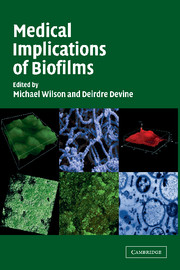Book contents
- Frontmatter
- Contents
- Preface
- List of Contributors
- PART ONE INTRODUCTORY CHAPTERS
- PART TWO BIOFILMS ON PROSTHETIC DEVICES
- 4 Animal Models of Orthopaedic Implant Infection
- 5 Intravascular-Catheter-Related Infections
- 6 Molecular Basis of Biofilm Formation by Staphylococcus epidermidis
- 7 Biofilm Complications of Urinary Tract Devices
- PART THREE ORAL BIOFILMS
- PART FOUR BIOFILMS ON SHEDDING SURFACES
- Index
- References
4 - Animal Models of Orthopaedic Implant Infection
Published online by Cambridge University Press: 23 November 2009
- Frontmatter
- Contents
- Preface
- List of Contributors
- PART ONE INTRODUCTORY CHAPTERS
- PART TWO BIOFILMS ON PROSTHETIC DEVICES
- 4 Animal Models of Orthopaedic Implant Infection
- 5 Intravascular-Catheter-Related Infections
- 6 Molecular Basis of Biofilm Formation by Staphylococcus epidermidis
- 7 Biofilm Complications of Urinary Tract Devices
- PART THREE ORAL BIOFILMS
- PART FOUR BIOFILMS ON SHEDDING SURFACES
- Index
- References
Summary
INTRODUCTION
More than 200,000 primary hip and 200,000 primary knee arthroplasties are performed each year in the United States alone. Between 0.5 and 3.9 per cent of them will become infected within 10 years (Table 4.1) (An and Friedman, 1996; Stocks and Janssen, 2000). For revision total joint replacements, the infection rates can be much higher, with numbers as high as 3.2 per cent reported by Sperling et al. (2001), 12.5 per cent reported by Itasaka et al. (2001), and 17 per cent reported by Spangehl et al. (1999). Infection often causes complete failure of a total joint arthroplasty. Sepsis following total joint replacement can have catastrophic results, both physically and psychologically, for the patient, leading to failure of the arthroplasty, prolonged hospitalisation, possible amputation, and even death (Cheatle, 1991). In addition, the management of infected cases, especially those of joint replacements, is very costly (Hebert et al., 1996). Although the use of prophylactic antibiotics and greatly improved surgical techniques have decreased the infection rate of joint replacement from an average of 5.9 per cent in 1975 to 1.2 per cent in 1993 (An and Friedman, 1996), challenges still remain for better preventive and therapeutic measures. In addition to joint replacement, implant infections also occur in other orthopaedic subspecialties, such as trauma (Eijer et al., 2001) and spine (Wimmer and Gluch, 1996), with a significant impact on the patient and society.
- Type
- Chapter
- Information
- Medical Implications of Biofilms , pp. 59 - 85Publisher: Cambridge University PressPrint publication year: 2003



